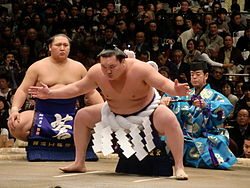Sumo wrestling originated in Japan, the only country where it is practiced professionally. There is six basho (tournaments) a year on the Grand Tournament Schedule, each lasting fifteen days. I am enjoying my fourth basho now. While I cannot begin to pronounce the names of the participants, I am beginning to immediately recognize some of the wrestlers and look forward to seeing these men challenge themselves and one another. Thanks to Wikipedia for beautiful photos.


According to Wikipedia, Sumo is a competitive full-contact wrestling sport. The (rikishi) wrestlers start off facing each other in the center of the (dohyo) circular ring. An attempt is made by one of the wrestlers to force the other out of the ring or to touch the ground with anything other than the soles of his feet.

Sumo to me is like watching “Body Ballet/Opera”. Let me explain. There is always respectful singing in the announcement of bout. The wrestler wears beautifully made garments such as their mawashi (loin cloth) and their embroidered silk apron. They stand facing each other focused, driven – determined to be at their individual best. They must think of the opponent, use strategy, and their own personal style of Sumo in the bout. Their bodies are in very good condition. Their movements are deliberate, precise – some times quite instantly creative. They must be humble, but, confident. They must display integrity. They must be able to perform through pain, rarely showing any physical difficulty. Amazing!! This is the way I see it.

Many ancient traditions have been preserved in sumo, and even today the sport includes many rituals and elements such as salt purification, from the day when sumo was used in the Shinto religion.

Life as a wrestler is highly regimented, with rules laid down by the Sumo Association. Most require that you live in a communal heya (“sumo training stable”) where all aspects of life from meals to manner of dress are dictated by strict tradition.

Amateur Sumo is found at the level of college and high school. It is even found at the grade school level but, at this level, it dispenses with most of the ceremony.

International Sumo Federation encourages this sport development worldwide. Their key aim is for it to become an Olympic sporting event. In Japan at present, there are 42 wrestlers in the makuuchi (highest) class, 13 come from foreign countries. The weight requirement upon entering (under 23 years) is up to 85 kg (190 lb) lightweight, up to 115 kg (250 lb) middle weight, and over 115 kg (250 lb) heavy weight, over that (unrestricted entry).
At the present time there are two Yokozunas (highest ranking wrestlers).






I always enjoy your snippets on what you encounter over there! Have you been to a live competition?
Yes, delighted, excited, amazed attending the May 2013 Basho. It was everything and more than what I had expected.